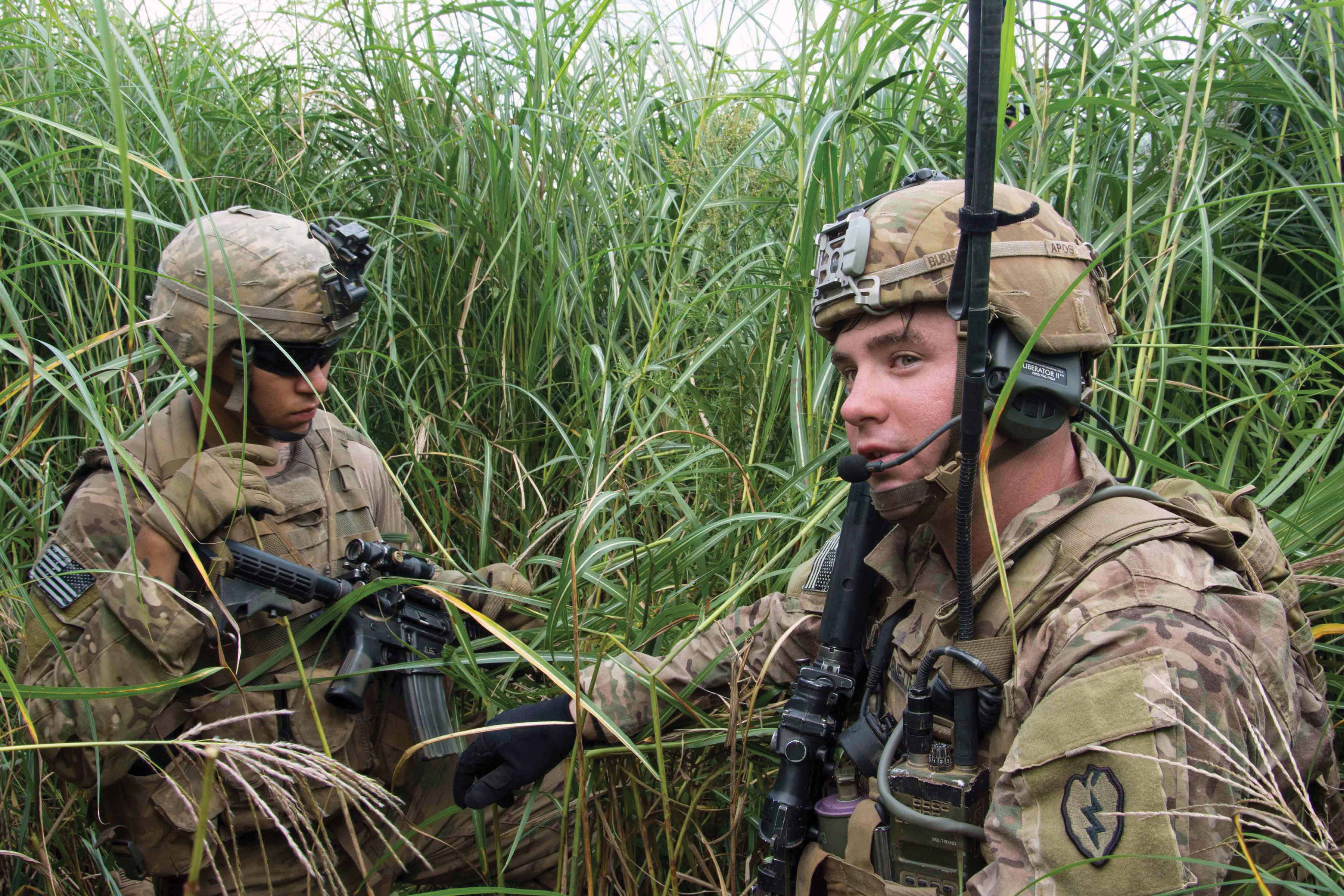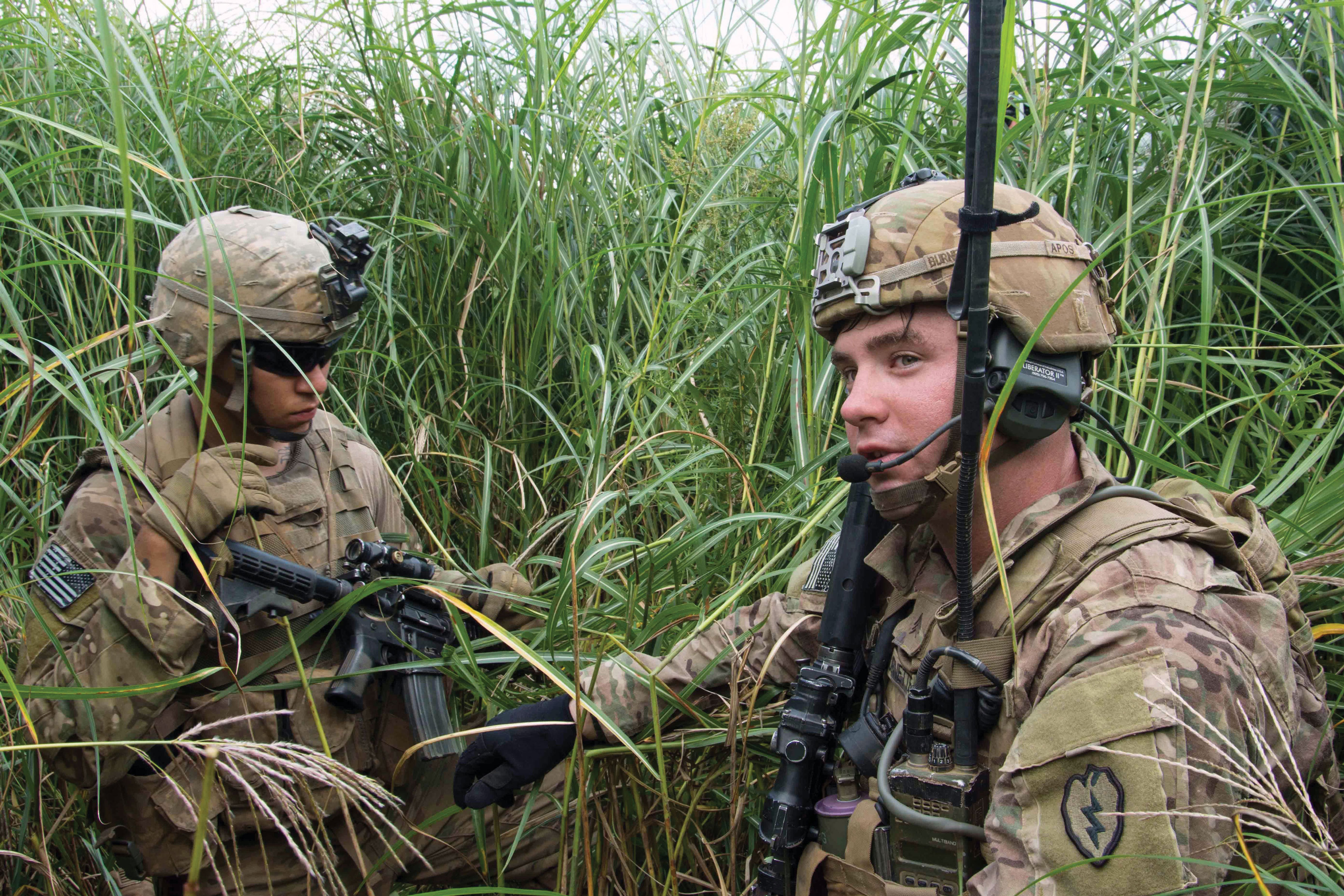
Targeted S&T supports new directions in network modernization by focusing on command, control, communications and intelligence capabilities for expeditionary operations featuring active electronic warfare.
by Ms. Nora Pasion
Army senior leaders have identified network command, control, communications and intelligence (C3I) as one of the Army’s six modernization priorities. Consistent with guidance from the chief of staff of the Army (CSA), the Army will move away from the existing network modernization path that lacked survivability, effectiveness, interoperability and suitability, and toward an expeditionary network enabling the Army to fight and win in all environments and against all enemies. To support this way forward, the Mission Command Network Modernization Implementation Plan will drive the development of the future Army network through four lines of effort (LOEs):
- Unified network.
- Common Operating Environment.
- Joint and coalition interoperability.
- Survivability and mobility of command posts.
The Network Modernization Implementation Plan defines each LOE in support of the CSA’s intent. LOE 1, unified network, will address unified transport and the supporting network enablers to provide assured network transport in a contested and congested environment. The second LOE, Common Operating Environment (COE), will focus on integrating the Joint Information Environment (JIE) and the associated applications that support commanders and leaders at echelon.
LOE 3 addresses interoperability in both JIE and mission partner environments, and supports the overall COE. Lastly, LOE 4 addresses the mobility and survivability of command posts (CPs), focusing on the capabilities that enable combat formations to conduct distributed mission command in an increasingly contested and congested environment against a peer adversary. This plan is grounded in the CSA’s first principles of modernizing to achieve critical operational requirements.
To provide warfighters with the necessary equipment to support the CSA’s modernization objectives, the Army is investing in science and technology (S&T) in the following network C3I and enabling areas: tactical communications and networking; assured positioning, navigation and timing (PNT); electronic warfare (EW); and cyber-electromagnetic activities (CEMA); mission command applications; persistent intelligence, surveillance and reconnaissance (ISR); and command post.
Following this article are three articles addressing select S&T concepts and research that support the network C3I portfolio across the near term (through 2025), midterm (2026-2035) and far term (beyond 2035): sensing in complex and congested environments; future Army Networks; and novel distributed processing approaches.

DATA Transfer Duty
Combat Cameraman Spc. Christopher Bellafant tests a data transmission system as part of tactical digital media training at Aberdeen Proving Ground, Maryland, in October. Army S&T investments in network modernization are focused on expeditionary, mobile and agile capabilities that increase combat effectiveness and improve decision-making and targeting. (U.S. Army photo by Dan Lafontaine, Program Executive Office for Command, Control and Communications – Tactical)
TACTICAL COMMUNICATIONS AND NETWORKING
To ensure information dominance on the battlefield, the Army’s tactical network must provide assured communications in contested, congested and degraded environments. This supports communications at the point of need and enables timely, decisive action. Army S&T investments are addressing these challenges through the research and development of automated and intelligent networks, anti-jam voice and data, autonomous platform communications, spectrum situational awareness (SA) and high-bandwidth commercial technologies.
ASSURED PNT
Unified land operations in multidomain environments require Army forces to access and integrate capabilities across space, cyber and EW domains to gain and maintain PNT superiority in support of joint operations. Transmission platforms that support unified land operations with unified action partners (or, “military forces, governmental and nongovernmental organizations, and elements of the private sector with whom U.S. Army forces plan, coordinate, synchronize, and integrate during the conduct of operations,” according to Army Doctrine Reference Publication 3-0, “Unified Land Operations”) must be assured and secure to deliver on-time situational awareness that allows operational units to act quickly and outmaneuver adversaries.
U.S. forces need the ability to prevent, degrade, eliminate and mitigate threats aimed at joint unified land operations while preserving friendly freedom of movement and action. S&T investments provide technologies that enable monitoring and control of the navigation warfare environment. Supported capabilities include electronic protection, support and attack; denying PNT capabilities to adversaries; and demonstrating -quantum-based, GPS-independent, ultra-high precision PNT in any environment. Other research efforts include developing modular GPS-independent sensors, open architecture sensor fusion capability and leading DOD’s PNT modeling and simulation collaborative initiative.

WHAT’S ON THE HORIZON?
An Expeditionary CEMA Team member surveys the battlefield near the mock city of Razish at the NTC in May as part of a training rotation for the 2nd Armored Brigade Combat Team, 1st Infantry Division under the CEMA Support to Corps and Below Initiative. Led by the U.S. Army Cyber Command (ARCYBER), the initiative started as a pilot to explore cyberspace capabilities and doctrine, and grew to encompass the integration of cyber with warfighting disciplines such as EW, information operations, intelligence and network operations. (U.S. Army photo by Bill Roche, ARCYBER)
ELECTRONIC WARFARE
EW provides an advantage over the adversary by enabling forces in operational areas to conduct electronic attack (EA), EW support (ES) and electronic protection (EP), in combination with other tactics. Army S&T investments are providing EW technologies for the mid and far term to enable ES, EA and SA through the foreseeable future. Research efforts are also producing standards-based, multifunction platforms in support of the Army EW strategy for unified land operations in 2025 and beyond.
CYBER-ELECTROMAGNETIC ACTIVITIES
Technologies are needed that harden critical network and weapon systems and protect these vital assets from emerging cyber threats as well as those that exploit the electromagnetic spectrum. These S&T investments deliver technologies that enable the resilience to fight through an attack and to acquire SA by leveraging tactical assets. These investments are expected to provide rapid access and effects to gain an advantage over adversaries.
Research efforts are also developing system architectures that support a war-fighting network platform in order to increase interoperability across operational domains, decrease the burden of training and enable the tactical delivery of cyber-electromagnetic effects.
MISSION COMMAND APPLICATIONS
Mission command applications must rapidly correlate and integrate data into useful information, enable rapid and accurate SA and reduce the number of Soldiers required for command post operations. Key capabilities include a common operating picture and awareness of cyberspace and the electromagnetic spectrum, which support commanders and leaders at all echelons and enable all warfighting functions.
Army S&T investments are delivering decision-support tools that implement standardized digital plans, model-based decision tools, automated sensor feed discovery, predictive visualization and machine learning to improve Soldier understanding, response time and accuracy, regardless of the tempo of operations.

TOMORROW’S COMMAND POST
The Missouri Army National Guard’s 35th Aviation Brigade sets up a command post under the Milky Way in May 2017 at the National Training Center (NTC), Fort Irwin, California, in support of the 155th Armored Brigade Combat Team’s NTC rotation. Army S&T investments will support mobile, scalable, tailorable command posts through servers, infrastructure and vehicle and equipment packages. (Mississippi National Guard photo by Staff Sgt. Tim Morgan, 102nd Public Affairs Detachment)
PERSISTENT ISR
To overcome range limitations and deliver accurate long-range precision and area fires, Army S&T provides capabilities that enable assured maneuverability through continuous battlespace SA. Enhanced SA reduces tactical surprise and prevents detection. Additionally, these assets increase the probability of target acquisition and deliberate operational engagement to defeat adversaries in an attack. S&T investments in this area include affordable, precision, standoff target identification and geolocation capabilities for mounted and dismounted Soldiers.
These programs are intended to assure speed and protection for ground forces. Complementary investments will include autonomous sensing of potential threats, sensor interoperability, multifunctional sensing, automatic target acquisition and data processing and synthesizing for Soldiers and units to employ for exploiting and disseminating information.
COMMAND POSTS
CPs enable commanders and their staff to visualize, comprehend, direct and synchronize operations continuously in all phases of unified land operations. CPs must enable units to conduct distributed operational mission command ranging from while en route to a crisis, during early entry to major combat operation and while rapidly integrating warfighting functions.
These CP capabilities are necessary to facilitate planning, collaboration and synchronized unified land operations with unified action partners, while reducing electronic and physical signatures to prevent hostile detection and targeting from enemy fires. Additionally, CP infrastructure must be deployable, mobile and survivable in a fast-paced, lethal fight. Army S&T investments will support a mobile, scalable and tailorable CP with improvements to CP infrastructure (including servers), power generation systems, vehicle and equipment packages, and other enabling technologies.

WEEDING OUT DIFFERENCES
Sgt. Joshua Burnette of 1st Stryker Brigade Combat Team, 25th Infantry Division instructs a member of his squad during Exercise Orient Shield 2017 at Camp Fuji, Japan, in September. The exercise is designed in part to enhance U.S. and Japanese combat readiness and interoperability at the tactical level, which is also a focus of S&T efforts for C3I. (U.S. Navy photo by Mass Communication Specialist 2nd Class Christopher Lange)
CONCLUSION
Focused network modernization is critical to achieve the Army’s desire to fight and win in any environment against any foe. In support of the Army’s top modernization priorities, Army S&T develops network C3I and enabling technologies in tactical communications and networking; assured PNT; EW; cyber-electromagnetic activities; mission command applications; persistent ISR; and CP technologies.
Collectively, these technologies enable expeditionary, mobile, agile, survivable, situationally aware and interoperable capabilities that increase combat effectiveness and improve -decision-making and targeting in future conflicts. To enable the Army to execute the conduct of war and remain prepared for war, these efforts are critical to aligning modernization efforts with the Army’s first principles.
For more information, go to https://www.army.mil/asaalt.
NORA PASION is director for the C3I portfolio in the Office of the Deputy Assistant Secretary of the Army for Research and Technology. She received an M.S. in industrial engineering and a B.S. in electrical engineering from New Mexico State University. She is Level III certified in engineering and Level I certified in S&T management and information technology. She holds active certifications for Certified Information Systems Security Professional and Certified Ethical Hacker.
Related link:
AUSA Eisenhower Luncheon, Oct. 10, 2017, including Gen. Milley’s keynote speech: https://www.dvidshub.net/video/557394/ausa-2017-eisenhower-luncheon
This article is published in the January – March 2018 issue of Army AL&T magazine.
Subscribe to Army AL&T News, the premier online news source for the Acquisition, Logistics, and Technology (AL&T) Workforce.







